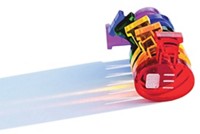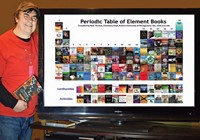Advertisement
Grab your lab coat. Let's get started
Welcome!
Welcome!
Create an account below to get 6 C&EN articles per month, receive newsletters and more - all free.
It seems this is your first time logging in online. Please enter the following information to continue.
As an ACS member you automatically get access to this site. All we need is few more details to create your reading experience.
Not you? Sign in with a different account.
Not you? Sign in with a different account.
ERROR 1
ERROR 1
ERROR 2
ERROR 2
ERROR 2
ERROR 2
ERROR 2
Password and Confirm password must match.
If you have an ACS member number, please enter it here so we can link this account to your membership. (optional)
ERROR 2
ACS values your privacy. By submitting your information, you are gaining access to C&EN and subscribing to our weekly newsletter. We use the information you provide to make your reading experience better, and we will never sell your data to third party members.
Education
Newscripts
Exploding Toads, Hair-Raising Work, Elements of Inspiration
by Bethany Halford
October 16, 2006
| A version of this story appeared in
Volume 84, Issue 42
Exploding Toads
Neither death nor postmortem pulverization, it seems, can stop cane toads from terrorizing the good people of Australia. The makers of ToadJus, a liquid fertilizer made from mashed up cane toads, recently warned gardeners Down Under that the product may spontaneously explode.
Cane toads have been the scourge of Australia ever since Aussie farmers imported 102 of the bumpy beasts to fight sugarcane pests in the 1930s. It was nothing short of an environmental disaster. With a toxic skin that poisoned any potential Aussie predators, the amphibians proliferated. As many as 100 million cane toads now hop throughout northeastern Australia, gobbling up just about everything except the aforementioned pests.
Killing cane toads has become something of an avocation amongst Aussies, but what to do with all those warty corpses? The environmental group FrogWatch NT decided the croaked croakers could give back to the continent if they were liquidized and made into fertilizer.
Unfortunately, the first batch of ToadJus hadn't ripened adequately before it was bottled, according to FrogWatch NT's Graeme Sawyer. He told the Australian news website News.com.au that residual fermentation causes pressure to build up in the bottles, which then explode leaving a harmless but evil-smelling, sticky liquid on kitchen shelves and gardening shed walls.
Sawyer suggests unscrewing the caps on unused bottles of ToadJus by half a turn to relieve pressure, adding, "I would particularly warn people against sending the novelty product to friends through the post."
Hair-Raising Work
In some truly hair-raising chemistry news, American Chemical Society employees Pamela J. Zaebst and Teresa M. Schleifer recently brought to our attention the CareerBuilder.com article, "12 Jobs that Let You Have Weird Hair." It seems that chemists—along with baristas and mascots—can sport an unusual 'do without damaging their career prospects, "so long as it's not in the way of anything flammable."
The conservatively coiffed Newscripts gang was dubious, but then we recalled that three lushly locked chemists won the 2004-05 Men of the Year award from the Luxuriant Flowing Hair Club for Scientists (LFHCfS) (C&EN, Jan. 24, 2005, page 60). In fact, Dmitry Mendeleyev, the father of the periodic table, tops LFHCfS's list of historical honorary members.
Elements of Inspiration

While we're not sure if Mendeleyev would be happy about his esteemed status in LFHCfS, we think he'd be thrilled with what Theodore W. Gray is calling "The Most Beautiful Periodic Table Poster in the World." Gray, cofounder of Wolfram Research and Popular Science columnist, turned his collection of more than 1,000 element samples into a striking photographic periodic table. "Every element has a pretty side, and in this poster I have tried to give each one a chance to show off what makes it unique and beautiful," he says.
The project started several years ago when Gray began collecting elements for his periodic table table-a periodic-table-shaped conference table containing actual element samples (C&EN, Sept. 22, 2003, page 38). "It was a complete disaster as a conference table," Gray admits. The elemental furniture simply proved too distracting.
Periodic tables are big sellers at science museum gift shops, so Gray decided to put his element collection to work. He says his periodic table, which only lists atomic numbers and weights alongside the vivid images, is not meant to replace those in classrooms. Rather, it's meant to augment them-an inspirational table to complement the traditional informational table.
You can order your own copy of Gray's table on his website, theodoregray.com. The table will also appear in the December issue of Popular Science, along with a column by Gray about his element-collecting hobby.
This week's column was written by Bethany Halford. Please send comments and suggestions to newscripts@acs.org.






Join the conversation
Contact the reporter
Submit a Letter to the Editor for publication
Engage with us on Twitter